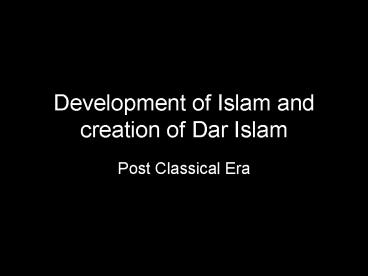Development of Islam and creation of Dar Islam PowerPoint PPT Presentation
1 / 6
Title: Development of Islam and creation of Dar Islam
1
Development of Islam and creation of Dar Islam
- Post Classical Era
2
how was Islam was able to spread from Spain to
India in a relatively short amount of time,
dominating a wide range of territories and
societies?
- Both religion and nationalism in precipitated
Muslim expansion. - Islam and Arabic combined
- Another contributing factor was the flexibility
of the military - The social structure and hardy nature of Arab
society lent itself to military operations of the
sort that conquered vast empires. - Emphasis should also be placed on the strength of
the Muslim economic, military, and political
systems, while recognizing that the conquered
territories were weak in those same areas.
3
Describe the evolution of Islamic civilization
and its impact on Europe.
- The foundation of Islamic civilization is the
Sharia, the law of Islam. - The Sharia envisions a community of believers
who are brothers and sisters and who share the
same moral values. - The adherence to the Sharia provided a common
cultural and secular set of laws throughout the
Islamic world despite ethnic or political
divisions. - The growth of urbanization contributed to the
rise of Islamic civilization. - Because of the growing number of converts to
Islam, the cities became a centerpiece for
conversion activities and the sharing of cultural
traditions. - The cities were the centers of Islam.
- They were the hub of commercial activities and
spread the knowledge of new crops to the
countryside, in particular, citrus fruits, rice,
sugar cane, and cotton. Intercity and
long-distance trade flourished, providing
important linkages between the city dwellers and
the countryside. - The manufacturing sector grew as well, especially
the production of cloth, metal goods, and
pottery. - The market economy grew under the strong
influence of Islamic ethics and law. - Science and medicine also flourished building on
the Hellenistic tradition and their own
experience, Muslim doctors and astronomers
developed skills and theories far in advance of
their European counterparts. - The Muslims shared their scientific and
intellectual traditions with Europe, in
particular, Spain and the Iberian peninsula,
creating in Spain the most diverse and
sophisticated agricultural economy in Europe. - The Spanish cities were larger and richer than
comparable European cities, and a unique
architectural and literary style emerged there.
4
Compare and contrast the Umayyad and Abbasid
caliphates, particularly regarding religion,
politics, and the military
- The Umayyads, coming to power in the seventh
century C.E., controlled an empire that was more
ethnically Arab than Islamic. - The military was primarily Arab, and the
political system was closely linked to their
Byzantine and Sasanid forebears. - y the time the Umayyads fell from power in 750,
less than 10 percent of the population consisted
of converts to Islam. - Rebellions against the legitimacy of the Umayyads
were frequent. - The Abbasid Caliphate was defined from the outset
by its Islamic foundation. - More and more converts were attracted into the
military and politics. - The Abbasids put a renewed emphasis on theology
and religious law. - They also marked a change in intellectual
tradition by translating Persian, Greek, and
Indian scholarship and thought. - The government became more complex and
cosmopolitan, and a new capital was built in
Baghdad. As more non-Arabs converted to Islam, - Islamic society included Greek, Iranian, Central
Asian, and African elements. - This sharing facilitated greater cultural
exchange, of which papermaking technology is a
great example. - This golden age of the Abbasid dynasty is also
demonstrated by the translation of works of
Aristotle into Arabic and the writing of the
stories of The Arabian Nights.
5
After Muhammads death why was there
fragmentation in the Empire ultimately creating
three different paths?
- The story of Ali is both personal and political
- He has a personal relationship with Muhammad that
leads to the conflict over the legitimate ruler
and the formation of the new position of caliph. - This continues with the Battle of the Camel and
the martyrdom of Husayn. - These conflicts result in
- the Sunni
- Shiite
- and Kharijite sects
6
Compare the status of Muslim women with the
status of women in other parts of the world at
that time.
- Nowhere in the world offered women equality.
- Women did not have equality as it is envisioned
in the modern sense anywhere in the world,
however, Muslim women did have certain rights
guaranteed them by Quranic law. - While European women did not have the right to
own property, divorce, and testify in court,
Muslim women are guaranteed these things by
Quranic law. - The topic of veiling is of particular interest as
well. - Although not an indigenous Arab custom, it is
adopted from the Byzantine and Sasanid Empires
and becomes a widespread custom in the Muslim
world but it performed in a variety of ways. - Elite women were restrained from public view more
strictly than lower status women. - Elite women were often secluded in the home or
went out covered completely to avoid the lustful
gaze of men outside of the family. - By covering or staying secluded, some women were
given access to the public world or the world of
scholarship. - Some elite women also were permitted to study and
become literate. - Women were also permitted to practice birth
control. - Muslim women have the same religious obligations
as Muslim men, including the pilgrimage to Mecca.
- Women in the Muslim world and most of the world
did not play a direct role in public affairs,
however, they did play an indirect role through
their husbands and sons.

